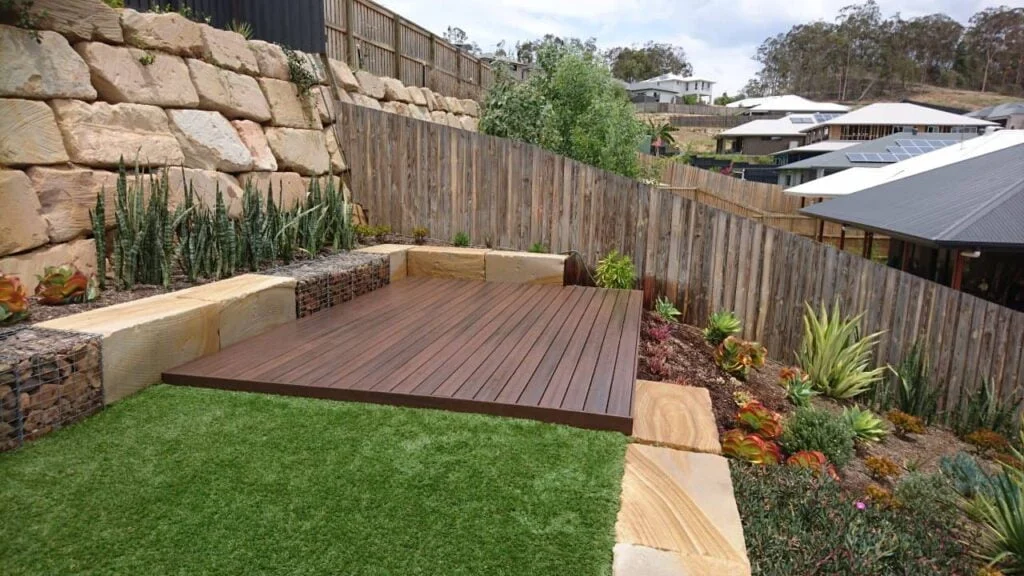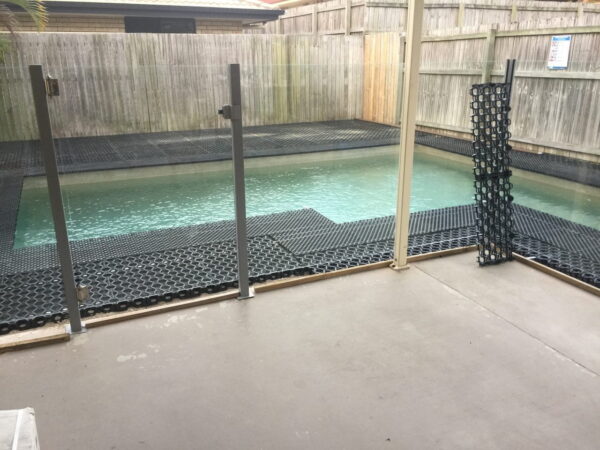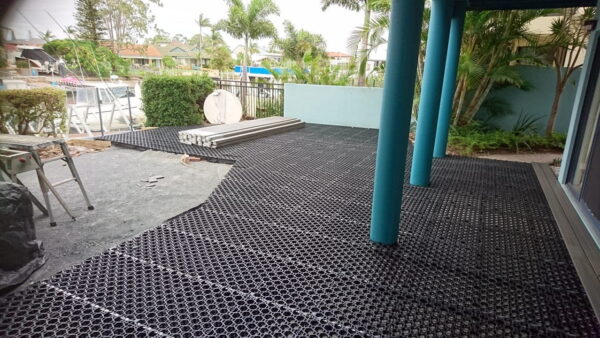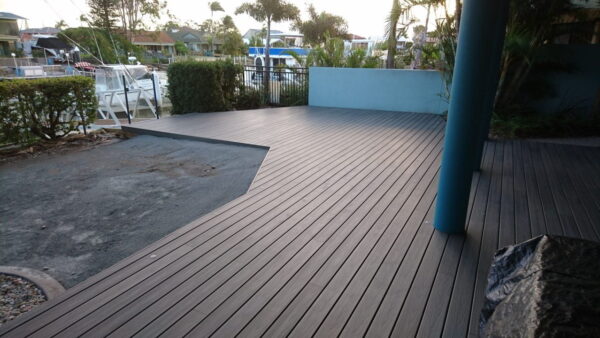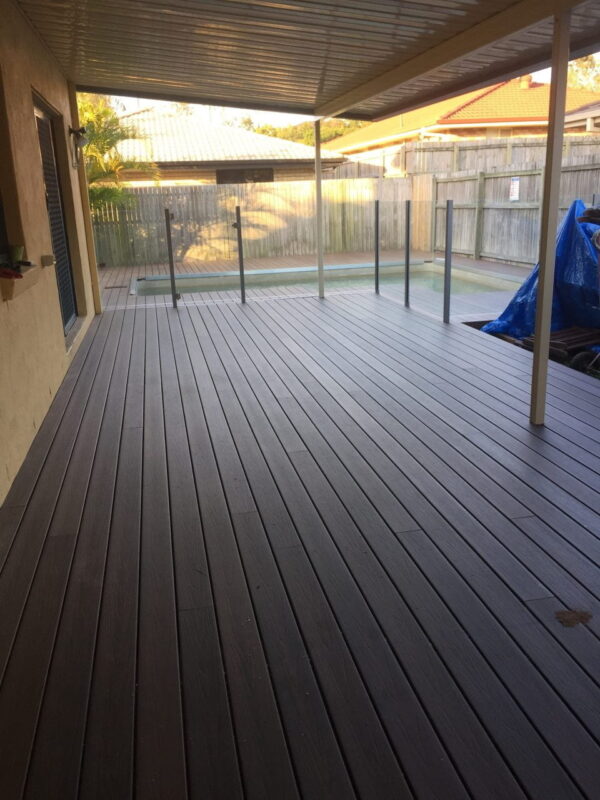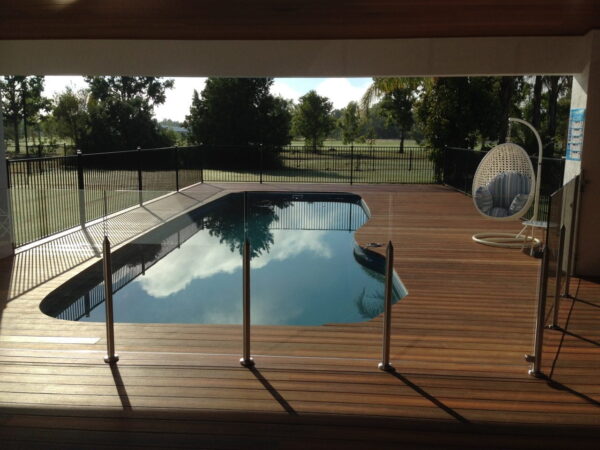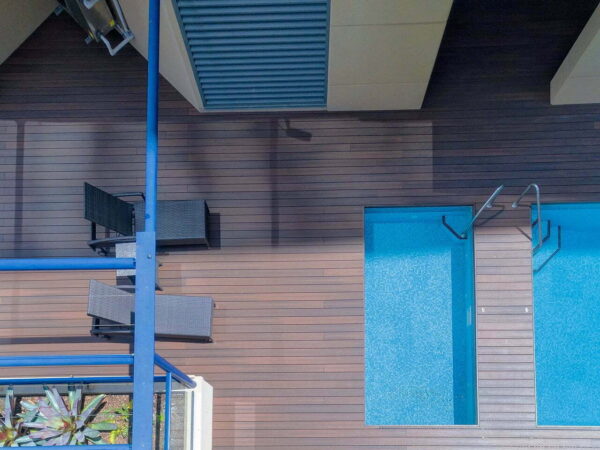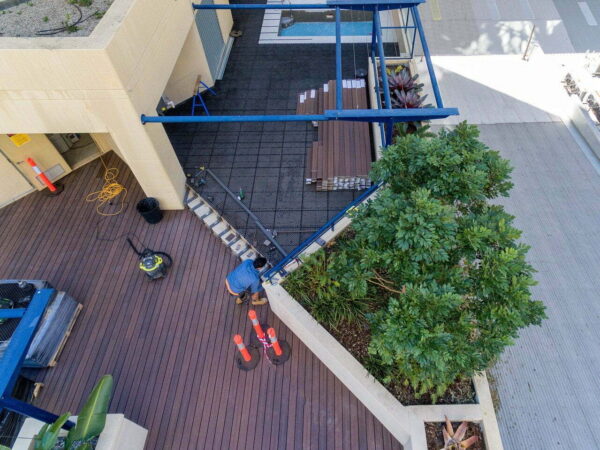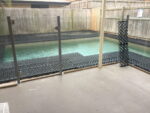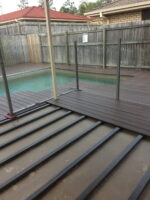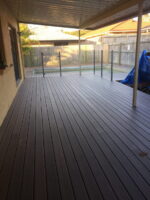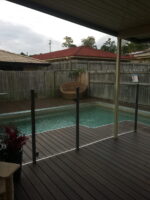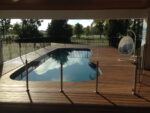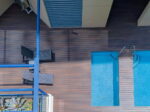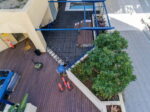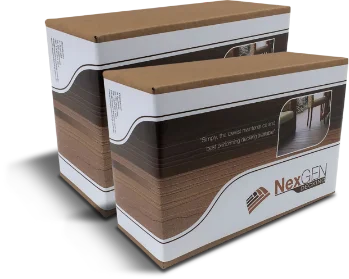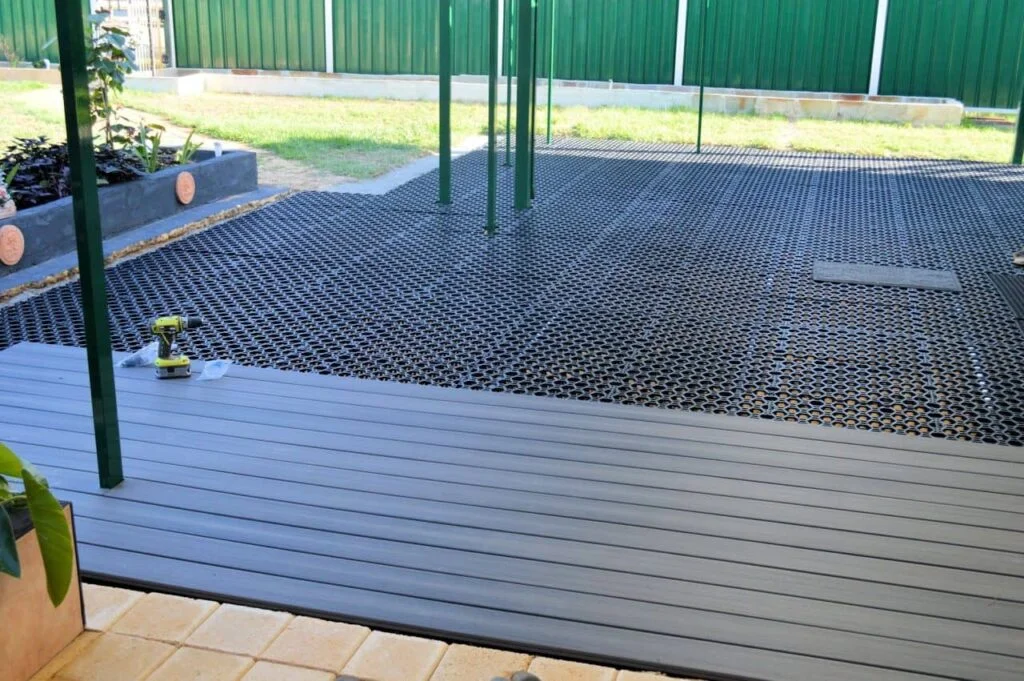
Australians love a bit of home renovation. In the September quarter of 2023, we spent more than $3 billion on alterations and additions.
While some ‘reno’ projects will always be a bit of a drag (like refitting a kitchen or bathroom), you can DIY a floating deck to create a beautiful outdoor living space with ease.
Upgrade Your Outdoors with a Low Deck
If you have been eyeing the drab concrete patio on your property and thinking it needs a style refresh – good news! A low level deck made from high quality composite decking boards can be installed over concrete, brick, pavers, or even compact sand. They also make an attractive update around pools.
With very little effort, you can make a very low deck over concrete and completely change the look and feel of your outdoor area.
In this blog we visit our top 8 reasons for building a floating deck, and how you can create one yourself.
8 Reasons Why You Should Install a Floating Deck
1. You can build a floating deck on top of concrete very quickly and easily.
Floating decking offers an effective means of camouflaging an existing concrete slab.
Our DIY DeckCell Subframe System is extremely quick and easy to install for even a novice.
2. A floating deck is ideal for balconies or multi-story buildings.
They are ideal for apartment complexes that feature outdoor living space. Raised decks capture the eye of onlookers and add to the curb appeal of your home.
3. You can build a new deck over concrete easily on your own.
Less planning, more doing and enjoying the final product. Floating decks are a low-labour option where you don’t have to dig or cut into any existing structures. You can also cover up dated-looking old concrete slabs with your choice of durable, wood-look boards.
Low level composite deck builds don’t typically require permissions or permits as they aren’t a house modification – making a floating deck ideal for long term tenancy, or for homeowners after a quick backyard fix.
Note: Check your local building codes to be sure you won’t be in violation with your planned backyard project.
4. Raised decks are low maintenance.
They are ideal for busy professionals who seek the lasting beauty of a deck without the hassle of daily maintenance. By choosing high-quality decking boards from composite material, you can eliminate the hassle of sanding, oiling, and cleaning the deck surface.
See our blog post on why our composite decking is basically maintenance free.
5. Floating deck projects are eye-catching.
Capped composite decking boards products feature a unique pattern on the top and bottom of each board, offering an effective combination of durability and visual variety.
Additionally, because they can be transported, you can easily reposition or relocate your floating deck.
6. You can easily install a floating deck over brick paving or level compact sand.
The nature of raised decks makes it easy for them to be installed over existing paving or sand. In fact, experts point to the installation of a floating deck as a cost-effective way of covering dated or worn brick or patio.
7. Composite deck boards are eco-friendly.
Environmentally conscious property owners are often delighted to know that they can build a floating deck that is made with eco-friendly recycled materials.
By using a durable Capped Composite Decking product to build your deck, you can enjoy the peace of mind that comes with a product manufactured using sustainable processes, that does not contain harmful chemicals.
8. People with floating decks tend to really enjoy them
Most property owners install a deck to improve the property’s functionality and liveability. Additionally, many homeowners indicate that installing a deck gives them a sense of enjoyment and accomplishment.
Building a Floating Deck: The Quick Guide
To create the perfect floating deck from NexGEN composite decking:
- Make sure your surface is suitable for a raised deck.
- Place the DeckCell subframe and lock it into place with Poly Joist.
- Lay the composite decking and attach securely to subframe using drill holes and hidden fasteners.
- Place and secure Fascia Boards to cap and cover outside edges.
- Enjoy your new ultra low maintenance deck for years to come.
Choose quality materials for your decking board
There are three layers to a floating deck.
- Ground or foundation (concrete slab, brick, tile patio, compacted sand)
- Subframe
- Composite decking
…and that’s all. No railings, posts, finding studs, or anchoring points to install. And with DeckCell, you’re assembling the subframe from easy-to-manage blocks rather than building it yourself with wood.
The major advantage of building a deck with NexGEN products is the fuss-free assembly, and long lasting result. The combination of DeckCell for the subframe and composite decking for the boards will not rot or otherwise deteriorate like traditional wood decking.
They also have next to no maintenance, aside from a quick sweep or wash with soapy water.
How to Build a Floating Deck: In More Detail
With NexGen DeckCell systems, the process is truly a DIY-ers dream. No need to install concrete footings or joist hangers for your new deck.
See a full visual break down of the process and product details on our DIY DeckCell Subframe System page.
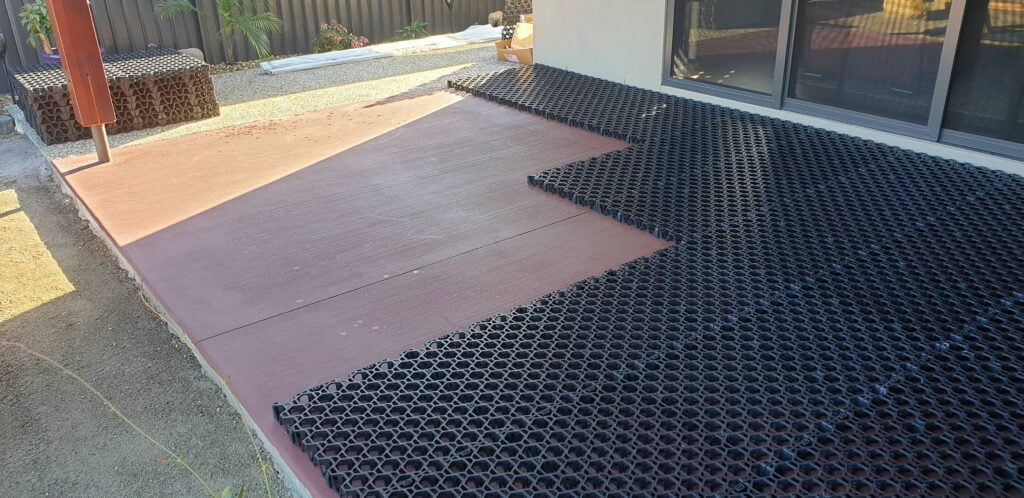
Building your floating deck with DeckCell:
1. Make sure you have everything you need before you start.
It sounds simple, but there’s nothing more dissatisfying than having an unfinished project because of some missing gear. From NexGEN’s product list you will need:
- DeckCell pieces for the subframe
- Composite decking boards in your preferred style
- Square Edge / Fascia Boards
- Deck screws
- Hidden Fixings
- Pro Plugs
- Poly Joists
- Driver bits
Some other tools you will need:
- Circular saw or jigsaw
- Electric or battery powered drill
- Measuring tape
- Drill bits
- Rubber mallet
Pro Tip: If you send NexGEN your measurements and plans, we can provide the whole kit for you. This means all you need to do is assemble and enjoy your final product.
2. Laying the DeckCell (subframe)
Starting from one side, lay the DeckCell. Start on the edge furthest from the house so any pieces needing to be cut will abut the building.
Lock the pieces in place using the male and female connectors. Using a rubber mallet will ensure solid and level connection.
Pro Tip: Lay out a completed mat first and then measure and make any trimmings, so you can trim the DeckCell down to minimise unnecessary cuts.
3. Trimming the DeckCell
If you need to trim the DeckCell pieces, measure and mark pieces first.
Trim marked areas using circular saw, jigsaw or shears. Once they have been cut, the altered DeckCell pieces will slot into place as normal.
Pro Tip: Don’t discard the offcuts just yet – they may come in handy for smaller areas.
4. Locking the DeckCell in place
Feed the Poly Joist through each section and trim off any excess. This will ensure a stable and long lasting deck. If your raised decking area is more than the Poly Joist length of 3 metres, these can be butted up against each other to extend length.
5. Installing your decking boards
Secure the starter board by screwing it into the Poly Joist below, plugging the hole with a Pro Plug. You will only need to screw the first and last boards flush with the DeckCell to secure them.
All other boards can be slotted together with hidden fixings into the side of the neighbouring boards, as well as hidden fixings above the Poly Joists to secure them to the base.

Are there cons of a low level deck on concrete?
Due to their durability and weatherproof materials, the usual issues for a low level wood deck build are not as applicable to composite projects.
On top of less maintenance overall, solid composite decking is termite resistant, temperature tested, and will not rot or warp from being close to the ground like wood will.
Selecting a Trusted Deck Expert
There are many reasons to enhance your home or business with a floating deck.
Once you decide to take the plunge and install a deck, you need to make sure that you seek the guidance of a trusted decking expert. Not all deck providers are created equal, so it’s important to carefully evaluate and ensure that you make the best choice.
You can cover up the old concrete slab with confidence when using NexGEN deck boards.
What puts NexGEN above the competition?
Our products have all the benefits and beauty of natural timber decking, minus the constant costly maintenance of sanding, oiling, even replacing sections over time.
NexGEN provides eco-friendly composite decking that is non-toxic, stays smooth underfoot, and can endure decades of quality family time without issue.
- Solid composite decking manufactured exclusively in the United States by Fiberon (reputable manufacturer with decades of experience and a proven track record).
- A strong international presence: Fiberon products are sold in more than 30 countries across Europe, Asia, and South America.
- A comprehensive stain, fade, and performance warranty – our products will last a lifetime against sun, moisture, heat or cold alike, even in harsh Australian conditions.
Related: Why you can’t afford to buy cheap composite decking
The hard-wearing, ecofriendly timber decking alternative
NexGEN Decking has local representatives stationed in Perth, Sydney, Melbourne, Brisbane and Adelaide. You can also contact us online to request a free sample from anywhere in Australia.
Get in touch today and our team can help you start your own decking project.
Contact Us
As an international leader in the decking industry, NexGEN offers all of the qualities outlined above. Offering a variety of durable products manufactured by Fiberon, NexGEN has served the residents of Australia for 15 + years now. Their strong market presence and unparalleled support have made NexGEN Australia’s most trusted provider of capped composite decking materials. We invite you to contact us to learn more about floating deck options and experience the NexGEN difference. We look forward to becoming your total solution to all of your decking needs!
Products
Gallery
Contact
Direct Office Numbers
Adelaide – (08) 6316 0469
Brisbane – (07) 3041 6065
Melbourne – (03) 8672 6444
Sydney – (02) 8072 6220

